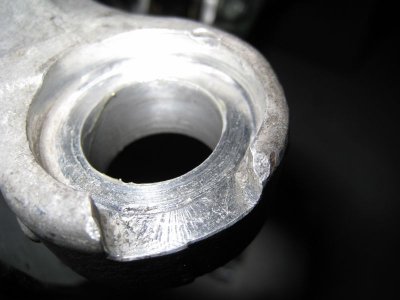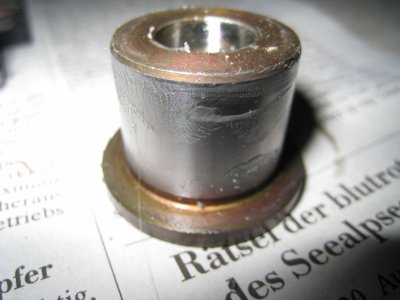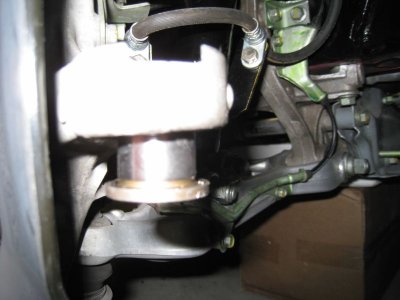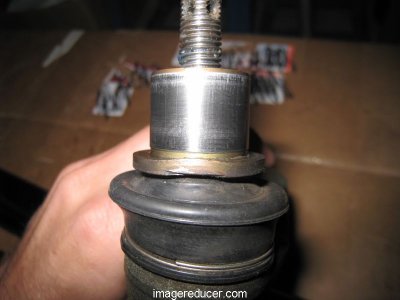Steering rod end - ball joint boot clip guide needed?
- Thread starter goldNSX
- Start date
If the steering rod ball joint is bad, a "pickle fork" type remover may work just fine, but will futher damage the rubber boot and possibly the already bad ball joint.
I tried a "regular" tie rod end removal tool (a specialized puller with two fixed hooks) and it pushed out the tie rod ball joint along with the steel sleeve that goes through the aluminum steering knuckle. It came out very easily - almost no real "pop". I then took the tied rod end & sleeve to a local shop that pressed the ball stud out of the sleeve. That took a lot of effort on their press.
The sleeve went back in easily simply using my fingers. There is a steel top cap that goes back on the sleeve. That pressed back on very easily using a large c-clamp.
So, as Larry B advised me, to avoid the intermediate steps, use the special tool.:biggrin:
I tried a "regular" tie rod end removal tool (a specialized puller with two fixed hooks) and it pushed out the tie rod ball joint along with the steel sleeve that goes through the aluminum steering knuckle. It came out very easily - almost no real "pop". I then took the tied rod end & sleeve to a local shop that pressed the ball stud out of the sleeve. That took a lot of effort on their press.
The sleeve went back in easily simply using my fingers. There is a steel top cap that goes back on the sleeve. That pressed back on very easily using a large c-clamp.
So, as Larry B advised me, to avoid the intermediate steps, use the special tool.:biggrin:
Oops, sorry. the mind was wandering.:redface: Now to answer the right question:
No, you don't need that boot clip guide. I was replacing only the boot and found it easy to "snap" the boot onto the groove using my fingers. I installed the "set ring" after the boot was in place, again simply using my fingers.
If the "set ring" is too tight, you can use two small pin punches or small screwdrivers as guides to help slide it down over the boot and into the groove in the boot.
I filled the boot fully with grease. Once the bottom of the boot is installed in the groove, push the top down so it is about where it will be after the joint is installed. Then fully wipe off any excess grease that squirts out from the tapered ball joint shaft section.
No, you don't need that boot clip guide. I was replacing only the boot and found it easy to "snap" the boot onto the groove using my fingers. I installed the "set ring" after the boot was in place, again simply using my fingers.
If the "set ring" is too tight, you can use two small pin punches or small screwdrivers as guides to help slide it down over the boot and into the groove in the boot.
I filled the boot fully with grease. Once the bottom of the boot is installed in the groove, push the top down so it is about where it will be after the joint is installed. Then fully wipe off any excess grease that squirts out from the tapered ball joint shaft section.
I purchased it years ago, and I have never used it . The clip goes on easily using your fingernail!!!
. The clip goes on easily using your fingernail!!!
Regards,
LarryB
Regards,
LarryB
Larry,
Sounds like a tool that can be used as a prize at NSXPO, River Run, etc. :biggrin:
Sounds like a tool that can be used as a prize at NSXPO, River Run, etc. :biggrin:
- Joined
- 15 May 2004
- Messages
- 6,898
I tried a "regular" tie rod end removal tool (a specialized puller with two fixed hooks) and it pushed out the tie rod ball joint along with the steel sleeve that goes through the aluminum steering knuckle. It came out very easily - almost no real "pop". I then took the tied rod end & sleeve to a local shop that pressed the ball stud out of the sleeve. That took a lot of effort on their press.
The sleeve went back in easily simply using my fingers.
I have the problem now that the sleeve won't go in the knuckle even though I've separated the tie-rod end before. With my fingers it moves about 2 mm in, with force maybe 3 or 4 mm but not more. After a full hour of trying on both sides and most of the easy technics, greasing and so on I think it's better to ask someone who ran into this before. The knuckle is very expensive and I don't feel like hammering the piece in as this is a safety area.
So, what's next?
Thanks!
Attachments
Your pictures seem to show the knuckle & sleeve surfaces are clean. But, I'd try a gentle metal polish that might remove oxide, but not remove healthy steel or aluminum. (Any opinions here as to the effects on the steel-aluminium interface?) In any case -- no sanding!
Grease may be a little too thick; I'd try some light weight oil (Mobil1 5w-30 for example).
Is it possible the sleeves got slightly distorted (ie, compressed & "fattened") when the ball studs were pressed out of the sleeves?
As I previously noted, mine went back in easily by finger pressure, to the point I was afraid it was too loose. But, after I inserted and torqued the nut everything was tight again. The ends were probably off on my '96 in 1999 when the EPS was replaced under warranty. They hadn't been touched since then until 2009.
Perhaps if you can get the sleeve started by hand, there may be enough length on the tied rod end stud to pull the sleeve through using the tie-rod end ball stud & nut? Just make sure you also install the steel cap on the top side first so the nut doesn't score the aluminum on the knuckle.
Good luck.
Grease may be a little too thick; I'd try some light weight oil (Mobil1 5w-30 for example).
Is it possible the sleeves got slightly distorted (ie, compressed & "fattened") when the ball studs were pressed out of the sleeves?
As I previously noted, mine went back in easily by finger pressure, to the point I was afraid it was too loose. But, after I inserted and torqued the nut everything was tight again. The ends were probably off on my '96 in 1999 when the EPS was replaced under warranty. They hadn't been touched since then until 2009.
Perhaps if you can get the sleeve started by hand, there may be enough length on the tied rod end stud to pull the sleeve through using the tie-rod end ball stud & nut? Just make sure you also install the steel cap on the top side first so the nut doesn't score the aluminum on the knuckle.
Good luck.
- Joined
- 15 May 2004
- Messages
- 6,898
Thanks for your help. I really appreciate it!
Just came from the garage and tried a technique my friend recommended my today. As you recommended I did some very fine sanding to remove any corrosion but only very, very slightly. This didn't help much but as you warned I didn't sand any further.
I fitted them in an hour ago with a heatgun on the aluminium and the sleeve getting cooled outside. I used a small parallel press to fit them in. Being very, very cautious (no mechanic would have the nerves and time I pretty sure of if it isn't his car :wink it took around an hour or so. One of them was not on block, maybe 2 mm away but my hope was fulfilled that it would go block while torqueing the castle nut. So far so good.
it took around an hour or so. One of them was not on block, maybe 2 mm away but my hope was fulfilled that it would go block while torqueing the castle nut. So far so good.  Now, I can't see tie rod ends for the rest of my life.
Now, I can't see tie rod ends for the rest of my life. 
Thanks again.
Just came from the garage and tried a technique my friend recommended my today. As you recommended I did some very fine sanding to remove any corrosion but only very, very slightly. This didn't help much but as you warned I didn't sand any further.
I fitted them in an hour ago with a heatgun on the aluminium and the sleeve getting cooled outside. I used a small parallel press to fit them in. Being very, very cautious (no mechanic would have the nerves and time I pretty sure of if it isn't his car :wink
Thanks again.
- Joined
- 15 May 2004
- Messages
- 6,898
Reviving an old thread. I had to pull bloody the tie-rod-ends once again. This time the sleeve came out again but got pressure from the tool on one side. Result: it's slightly bent on one lower side. WTF! What to do? I don't like to push it against the softer aluminium this way. The part manual says: buy a new knuckle. $600, thanks. If I hammer it back to shape the chance is high enough that the upper part gets deformed as well I think which diminishes the chances to put it back. It was a headache last time. 
Can you show us a pic of "slighly bent"??
- Joined
- 15 May 2004
- Messages
- 6,898
Larry, this is how it looks like. Should I try repairing it or watch out for a crashed car's one? Repairing would mean putting it firmly in a vice, heat it up and hammer on it precisely and grind the rest of it off until it's flat.
Just an idea. How about if you have a sleeve that fits over the diameter, like a pipe that the ID is just larger then the bushing. Use this in a press to flaten the flange section. You will need to remove it from the tie rod end to do this.
HTH,
LarryB
I wouldn't hammer it; the dent from the top is cosmetic.
Just "clean up" the "inside" shoulder and that should work fine.
Just "clean up" the "inside" shoulder and that should work fine.
Just an idea. How about if you have a sleeve that fits over the diameter, like a pipe that the ID is just larger then the bushing. Use this in a press to flaten the flange section. You will need to remove it from the tie rod end to do this.
HTH,
LarryB
Good idea.
Perhaps using a socket, say a impact socket.
Last edited:
Similar threads
- Replies
- 0
- Views
- 349
- Replies
- 4
- Views
- 907







